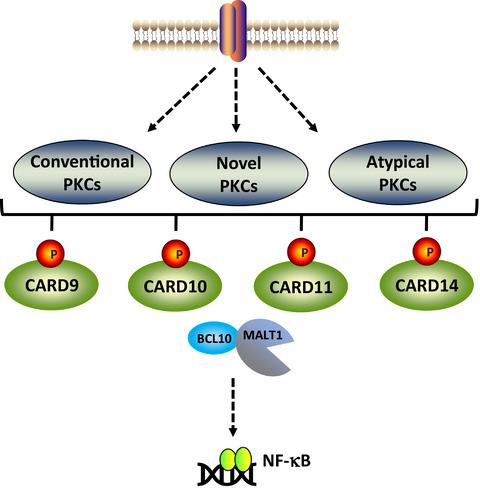Our official English website, www.x-mol.net, welcomes your
feedback! (Note: you will need to create a separate account there.)
Defining the combinatorial space of PKC::CARD‐CC signal transduction nodes
The FEBS Journal ( IF 5.5 ) Pub Date : 2020-08-13 , DOI: 10.1111/febs.15522 Jens Staal 1, 2 , Yasmine Driege 1, 2 , Mira Haegman 1, 2 , Marja Kreike 1, 2 , Styliani Iliaki 1, 2 , Domien Vanneste 1, 2 , Marie Lork 1, 2 , Inna S Afonina 1, 2 , Harald Braun 1, 2 , Rudi Beyaert 1, 2
The FEBS Journal ( IF 5.5 ) Pub Date : 2020-08-13 , DOI: 10.1111/febs.15522 Jens Staal 1, 2 , Yasmine Driege 1, 2 , Mira Haegman 1, 2 , Marja Kreike 1, 2 , Styliani Iliaki 1, 2 , Domien Vanneste 1, 2 , Marie Lork 1, 2 , Inna S Afonina 1, 2 , Harald Braun 1, 2 , Rudi Beyaert 1, 2
Affiliation

|
Signal transduction typically displays a so‐called bow‐tie topology: Multiple receptors lead to multiple cellular responses but the signals all pass through a narrow waist of central signaling nodes. One such signaling node for several inflammatory and oncogenic signaling pathways is the CARD‐CC/BCL10/MALT1 (CBM) complexes, which get activated by protein kinase C (PKC)‐mediated phosphorylation of the caspase activation and recruitment domain (CARD)‐coiled‐coil domain (CC) component. In humans, there are four CARD‐CC family proteins (CARD9, CARD10, CARD11, and CARD14) and 9 true PKC isozymes (α to ι). At this moment, less than a handful of PKC::CARD‐CC relationships are known. In order to explore the biologically relevant combinatorial space out of all 36 potential permutations in this two‐component signaling event, we made use of CARD10‐deficient human embryonic kidney 293T cells for subsequent pairwise cotransfections of all CARD‐CC family members and all activated PKCs. Upon analysis of NF‐κB‐dependent reporter gene expression, we could define specific PKC::CARD‐CC relationships. Surprisingly, as many as 21 PKC::CARD‐CC functional combinations were identified. CARD10 was responsive to most PKCs, while CARD14 was mainly activated by PKCδ. The CARD11 activation profile was most similar to that of CARD9. We also discovered the existence of mixed protein complexes between different CARD‐CC proteins, which was shown to influence their PKC response profile. Finally, multiple PKCs were found to use a common phosphorylation site to activate CARD9, while additional phosphorylation sites contribute to CARD14 activation. Together, these data reveal the combinatorial space of PKC::CARD‐CC signal transduction nodes, which will be valuable for future studies on the regulation of CBM signaling.
中文翻译:

定义PKC :: CARD-CC信号转导节点的组合空间
信号转导通常表现出所谓的领结拓扑:多个受体导致多种细胞反应,但信号均通过中央信号传导节点的狭窄腰部。CARD-CC / BCL10 / MALT1(CBM)复合物是几种炎性和致癌信号通路的信号传导节点,它们被蛋白激酶C(PKC)介导的半胱天冬酶激活和募集结构域(CARD)盘绕的磷酸化激活线圈域(CC)组件。在人类中,有四种CARD-CC家族蛋白(CARD9,CARD10,CARD11和CARD14)和9种真正的PKC同工酶(α至ι)。目前,已知的PKC :: CARD-CC关系很少。为了从该两成分信号事件中的所有36个潜在排列中探索生物学相关的组合空间,我们利用缺少CARD10的人类胚胎肾293T细胞对所有CARD-CC家族成员和所有激活的PKC进行随后的成对共转染。通过分析依赖于NF-κB的报告基因的表达,我们可以定义特定的PKC :: CARD-CC关系。令人惊讶的是,已鉴定出多达21种PKC :: CARD-CC功能组合。CARD10对大多数PKC有反应,而CARD14主要由PKCδ激活。CARD11激活配置文件与CARD9最相似。我们还发现了不同CARD-CC蛋白之间存在混合蛋白复合物,这表明它们会影响其PKC反应谱。最后,发现多个PKC使用共同的磷酸化位点来激活CARD9,而其他磷酸化位点则有助于CARD14的激活。一起,
更新日期:2020-08-13
中文翻译:

定义PKC :: CARD-CC信号转导节点的组合空间
信号转导通常表现出所谓的领结拓扑:多个受体导致多种细胞反应,但信号均通过中央信号传导节点的狭窄腰部。CARD-CC / BCL10 / MALT1(CBM)复合物是几种炎性和致癌信号通路的信号传导节点,它们被蛋白激酶C(PKC)介导的半胱天冬酶激活和募集结构域(CARD)盘绕的磷酸化激活线圈域(CC)组件。在人类中,有四种CARD-CC家族蛋白(CARD9,CARD10,CARD11和CARD14)和9种真正的PKC同工酶(α至ι)。目前,已知的PKC :: CARD-CC关系很少。为了从该两成分信号事件中的所有36个潜在排列中探索生物学相关的组合空间,我们利用缺少CARD10的人类胚胎肾293T细胞对所有CARD-CC家族成员和所有激活的PKC进行随后的成对共转染。通过分析依赖于NF-κB的报告基因的表达,我们可以定义特定的PKC :: CARD-CC关系。令人惊讶的是,已鉴定出多达21种PKC :: CARD-CC功能组合。CARD10对大多数PKC有反应,而CARD14主要由PKCδ激活。CARD11激活配置文件与CARD9最相似。我们还发现了不同CARD-CC蛋白之间存在混合蛋白复合物,这表明它们会影响其PKC反应谱。最后,发现多个PKC使用共同的磷酸化位点来激活CARD9,而其他磷酸化位点则有助于CARD14的激活。一起,











































 京公网安备 11010802027423号
京公网安备 11010802027423号